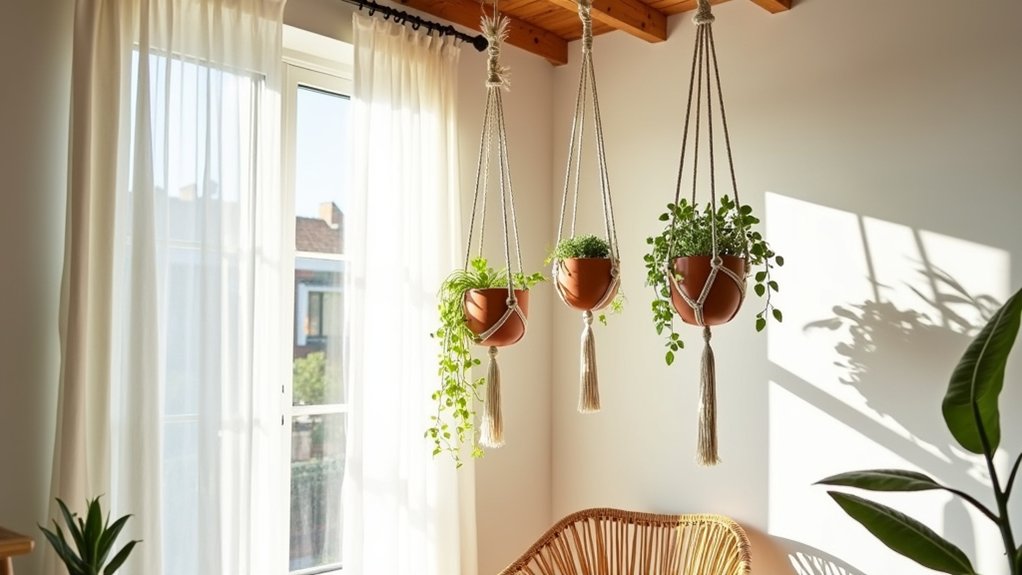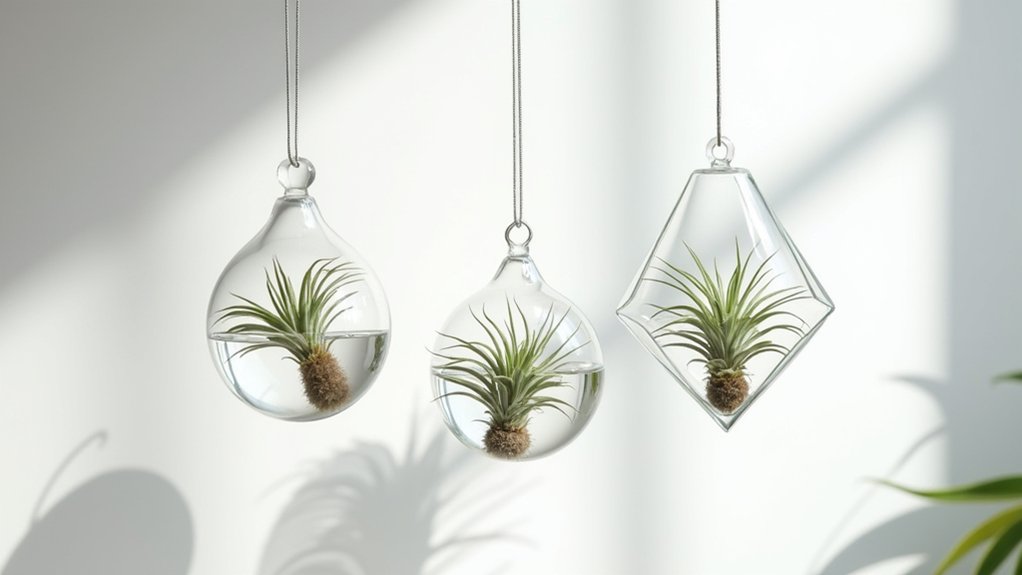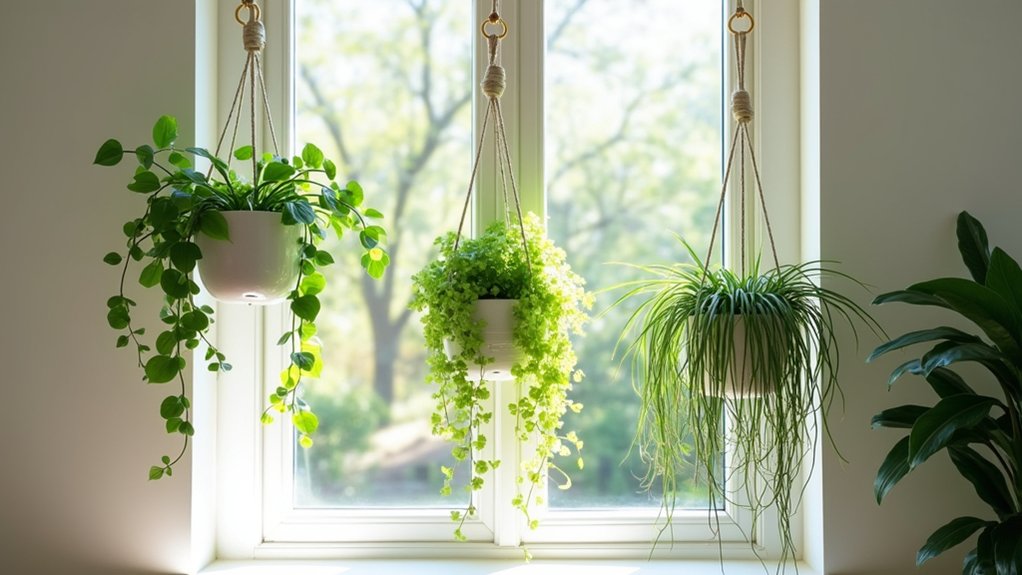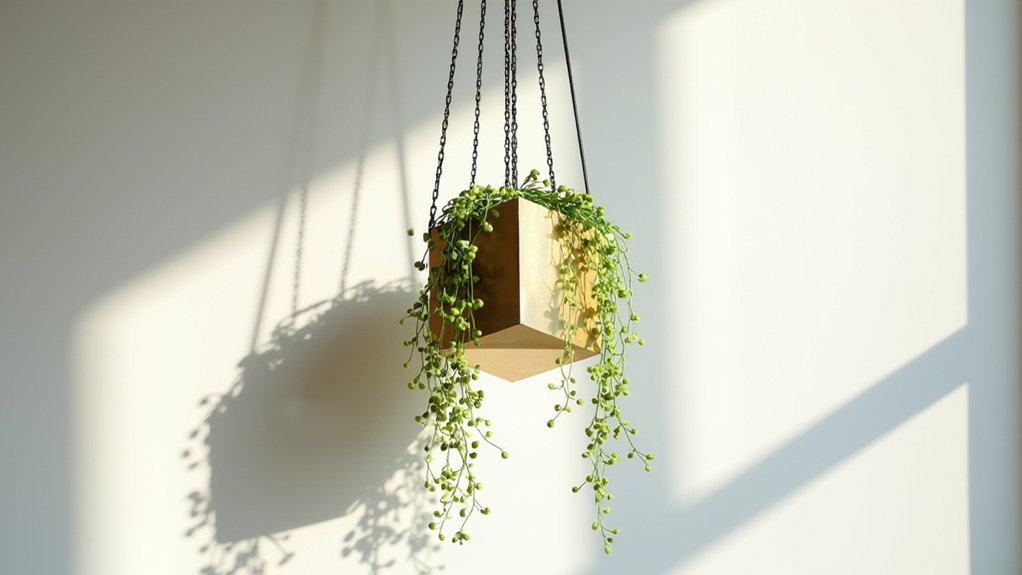Just as you’ve been thinking about refreshing your living space, indoor hanging plants have emerged as this year’s most versatile decor trend. You’ll discover how these elevated greenery displays can transform empty corners, bare walls, and unused vertical spaces into stunning focal points that purify your air while adding natural beauty. From classic macramé holders to modern geometric designs, each of these eight creative approaches offers a unique way to bring your interior design vision to life.
Contents
Macramé Magic: Boho-Inspired Plant Displays

Macramé plant hangers bring a distinctly bohemian aesthetic to indoor spaces, featuring intricate knotted patterns created from natural cotton or jute cord.
These decorative holders cradle plant pots in suspended networks of geometric designs, tassels, and beaded accents, allowing plants to cascade dramatically from ceiling hooks or wall brackets.
The versatile nature of macramé displays works particularly well with trailing plants like pothos, string of pearls, or spider plants, creating an artisanal fusion of vintage craft and modern plant parenting.
- Position macramé hangers 2-3 feet from windows for optimal indirect light
- Choose lightweight plastic or ceramic pots to prevent stress on hanging hardware
- Ensure macramé cords can support the weight of both pot and plant when wet
- Select locations away from heating/cooling vents to prevent cord degradation
- Install into ceiling joists or use appropriate wall anchors rated for the total weight
Regular maintenance of macramé plant displays involves more than just plant care.
Dust the cords monthly with a dry cloth to prevent dirt buildup, and inspect knots periodically for signs of loosening or wear.
Rotate the hanging plants quarterly to ensure even growth, and consider removing the plant to wash the macramé annually in mild soap and water, allowing it to dry completely before reinstalling.
When watering, place a drip tray beneath the pot or take the plant to a sink to prevent water damage to floors and furniture below.
Vintage Brass Planters for Classic Elegance

Vintage brass planters bring timeless sophistication to indoor spaces, featuring warm metallic finishes that develop a distinguished patina over time.
These decorative containers, often adorned with intricate patterns or geometric designs, range from simple hanging bowls to elaborate tiered systems. The natural antibacterial properties of brass make these planters particularly suitable for indoor plants, while their weight provides stability for larger specimens.
- Light: Bright, indirect sunlight to prevent overheating of the metal container
- Water: Needs drainage holes or inner liner to prevent water accumulation
- Soil: Well-draining potting mix with added perlite
- Temperature: Maintain between 65-75°F (18-24°C)
- Humidity: Regular misting to offset potential drying effects of metal
- Weight capacity: Ensure mounting hardware can support planter when fully loaded
Regular maintenance of vintage brass planters requires periodic polishing to maintain their lustrous appearance, though some gardeners prefer to let the natural patina develop.
Check mounting hardware quarterly for security, and inspect the planter’s bottom for any corrosion or water damage. Clean the planter’s surface monthly with a gentle brass cleaner, avoiding harsh chemicals that could leach into the soil.
Insert a plastic liner if the planter lacks one to protect both the brass from soil minerals and the plant roots from potential metal oxidation.
Floating Glass Terrariums and Air Plants

Floating glass terrariums paired with air plants create ethereal, suspended gardens that add a contemporary touch to any indoor space.
These transparent vessels come in various geometric shapes and can be hung from the ceiling or mounted on walls, allowing air plants (Tillandsia) to appear as if they’re floating in mid-air. The combination of clear glass and these rootless plants creates a minimalist, almost sculptural effect that’s both visually striking and space-efficient.
- Light: Bright, indirect sunlight; avoid direct sun which can burn plants and create excessive heat inside the glass
- Humidity: 50-70% humidity; misting 2-3 times weekly
- Temperature: 50-90°F (10-32°C)
- Growing Medium: No soil needed; air plants absorb nutrients through their leaves
- Ventilation: Requires good air circulation to prevent moisture buildup
- Container Material: Clear glass with openings for airflow
To maintain these suspended gardens, regularly remove air plants from their terrariums for thorough soaking in room temperature water for 20-30 minutes every 1-2 weeks.
After soaking, shake off excess water and allow plants to dry completely upside down before returning them to their terrariums to prevent rot. Clean glass surfaces monthly with a gentle glass cleaner, and inspect plants for signs of dehydration (curling or rolling leaves) or overwatering (brown or black bases).
Rotate terrariums periodically to ensure even light exposure and growth.
Minimalist Wire Plant Hangers

Wire plant hangers embody modern simplicity with their clean lines and geometric shapes, offering an understated way to display indoor plants.
These minimalist hangers typically feature thin metal wire bent into basic patterns like circles, diamonds, or triangles, often with a matte black, brass, or copper finish. The stripped-down design allows the plant to take center stage while adding an architectural element to any room’s décor.
- Light: Works well in any lighting condition, depending on the plant being displayed
- Location: Best mounted 6-12 inches from windows or walls
- Weight capacity: Generally supports plants up to 5-7 pounds
- Material durability: Powder-coated or sealed wire prevents rust
- Installation: Requires sturdy ceiling hooks or wall brackets
- Spacing: Minimum 18 inches between hangers for visual balance
Regular maintenance involves checking the wire’s tension points and mounting hardware every few months to ensure security.
Wipe the wire with a dry cloth to prevent dust buildup, and inspect for any signs of corrosion, especially in humid environments.
When repotting plants, consider the hanger’s weight limits and adjust pot sizes accordingly to maintain proper balance and prevent strain on the mounting points.
Ceiling-Mounted Plant Clusters

Ceiling-mounted plant clusters create a dramatic natural canopy by grouping multiple hanging plants at varying heights from ceiling hooks or mounted rods. This arrangement transforms empty overhead space into a living tapestry, with plants cascading at different levels to add depth and visual interest. Popular choices for clusters include pothos, spider plants, string of pearls, and air plants, which can be arranged symmetrically or in organic patterns to suit the room’s aesthetic.
- Light: Bright indirect light is optimal; avoid direct sunlight which can burn leaves
- Water: Moderate watering schedule, allowing top inch of soil to dry between waterings
- Soil: Well-draining potting mix with added perlite or orchid bark
- Temperature: 65-80°F (18-27°C)
- Humidity: 40-60% humidity levels
- Spacing: Minimum 12 inches between plants to allow for growth
- Container: Lightweight pots with drainage holes and saucers to prevent leaks
Regular maintenance for ceiling-mounted clusters requires strategic planning due to their elevated position. Use a sturdy stepladder for weekly inspections, and consider installing a pulley system for easier watering access.
Rotate plants quarterly to ensure even growth, trim yellowing or dead foliage promptly, and dust leaves monthly with a damp cloth to maintain photosynthesis efficiency. Check mounting hardware every six months to ensure it remains secure and can support the increasing weight of growing plants.
Dramatic Corner Cascades

Dramatic corner cascades create striking visual interest by positioning trailing plants in room corners, allowing their foliage to flow downward in elegant, living waterfalls. These installations typically feature plants with long, trailing vines such as pothos, string of pearls, or English ivy arranged in hanging baskets or wall-mounted planters positioned at varying heights.
The layered effect draws the eye upward while softening architectural lines and maximizing vertical space in otherwise unused corners.
- Light: Bright to moderate indirect light; avoid direct sunlight which can scorch leaves
- Water: Allow top 1-2 inches of soil to dry between waterings
- Soil: Well-draining potting mix with added perlite
- Humidity: Moderate to high (50-60%)
- Temperature: 65-80°F (18-27°C)
- Container: Hanging baskets with drainage holes or wall-mounted planters
- Spacing: Position plants 18-24 inches apart for optimal cascading effect
Regular pruning and grooming are essential to maintain the aesthetic appeal of corner cascades. Trim damaged or yellowing leaves promptly, and cut back overgrown vines to encourage fuller growth and prevent tangles.
Rotate containers quarterly to ensure even growth, and dust leaves monthly with a damp cloth to maintain their luster and photosynthetic efficiency. Support newly growing vines with small hooks or clear fishing line to guide their direction until they establish their natural cascade.
Window-Framing Plant Arrangements

Window-framing plant arrangements create a living curtain effect by strategically positioning hanging plants around window frames to enhance natural light and create visual interest. These arrangements typically feature cascading plants of varying lengths and textures, installed at different heights to frame the window without blocking essential light.
Plants can be hung using decorative macramé holders, ceiling hooks, or mounted brackets, creating layers of greenery that soften the window’s hard edges while maintaining the view.
- Light: Bright, indirect sunlight; morning sun is ideal
- Water: Varies by plant selection; generally water when top inch of soil feels dry
- Soil: Well-draining potting mix with added perlite
- Temperature: 65-80°F (18-27°C)
- Humidity: 40-60% relative humidity
- Container: Hanging planters with drainage holes
- Spacing: 12-18 inches between plants to allow for growth
Regular grooming is essential for maintaining attractive window-framing arrangements. Rotate plants quarterly to ensure even growth, trim yellowing or dead foliage promptly, and dust leaves monthly to maximize light absorption.
Check hanging hardware monthly for security, and adjust plant heights seasonally to accommodate growth and maintain the desired framing effect. During winter, move plants slightly away from window glass to protect from cold drafts while still maintaining the aesthetic arrangement.
Modern Geometric Plant Holders

Modern geometric plant holders blend contemporary design with botanical display, featuring clean lines and angular shapes crafted from materials like brass, steel, or powder-coated metal.
These striking vessels often incorporate triangles, hexagons, or diamond patterns, suspended by sleek cables or chains to create floating garden artwork.
The minimalist aesthetic of these holders can range from simple wireframe designs to more complex multi-tiered arrangements, making them ideal for displaying air plants, trailing vines, or compact succulents while serving as architectural focal points in any room.
Growing Conditions:
- Mount in areas receiving indirect to bright filtered light, avoiding direct sun that can heat metal containers
- Choose plants appropriate for the holder’s size and depth
- Use lightweight, well-draining potting mix for contained plants
- Position away from heating/cooling vents to prevent temperature fluctuations
- Install in sturdy ceiling joists or wall anchors rated for the total weight when wet
Regular handling checks ensure cables and mounting hardware remain secure, while periodic cleaning with a soft cloth keeps metal surfaces free from dust and water spots.
Rotate holders quarterly to promote even growth, and inspect connection points where metal meets metal for any signs of wear or corrosion.
When repotting, consider using plastic liner pots inside metal holders to protect against moisture damage and make plant maintenance easier.
